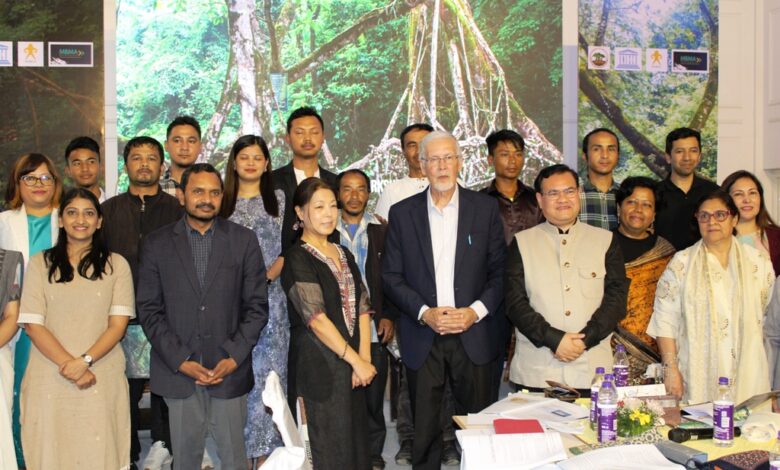
Shillong, May 27: Meghalaya missed the February deadline to submit the nomination of ‘Living Root Bridges’ for consideration by United Nations Educational Scientific and Cultural Organisation(UNESCO).
According to Junhi Han, Chief Culture Sector & Programme Specialist, UNESCO, South Asia Regional Office, New Delhi, the deadline for submission is beginning of February every year and the procedure takes one and a half years.
The proposal will have to be examined by the World Heritage Commitee and as far as Meghalaya is concerned it will be examined only in 2027 as the state has not submitted the proposal in February.
The UNESCO official and her team attended the inaugural workshop held at the Heritage Club, Tripura Castle, here on guiding the preparation of world heritage nomination dossier for Living Root Bridges(Jingkieng Jri) Cultural Landscapes supported by Meghalaya Government, UNESCO, Indian National Trust for Art and Cultural Heritage (INTACH) and Meghalaya Basin Management Authority (MBMA).
The team will visit the bridges on Wednesday.
She said the Meghalaya Living Root Bridges made of rubber tree (ficus elastica) are unique compared to traditional bridges made of cane and bamboo by Lepcha communities in the Dzongu Tribal Reserve under the Khangchendzonga Biosphere Reserve in Sikkim.
This is also different from traditional water channel systems in Oman, Persia and Iran.
Tracing the process, Han said Chief Minister Conrad Sangma, went to Paris and met Assistant Director General Culture UNESCO Dr Ernesto Renato Ottone Ramirez. The chief minister spoke about living root bridges and the UNESCO official was very impressed.
Han said not just living root bridges but the associated traditional knowledge of the community makes them special .
“The UNESCO headquarters contacted us to visit the areas to provide technical assistance to the government of Meghalaya especially in transmitting the traditional knowledge system and to make the inventory of the incredible living root bridges”, she told reporters after the inaugural event.
The root bridges and land scapes go beyond the tradition, there is also the belief system, way of living and the capacity of the community to survive the environment which means resilience, she said.
“Currently, the concern of the government is to finalise the world heritage nomination dossier but our coming here goes beyond the nomination aspect as we would like to see that this tradition continues.. . Transmission of knowledge and conservation is beyond the world heritage inscription and there is also a need to overcome the tourism and development pressures.
Reference in 1844
Earlier, during the inaugural workshop, Principal Secretary, Arts and Culture Frederick Kharkongor said the matter was first recorded in a sketch by Henry Yule, the Scottish Geographer & Orientalist.
He was the first to document it in 1844 while publishing his observations in the journal of the Asiatic Society of Bengal and called them Living Bridges….” He says That the bridge by which we cross is worthy of description ,as I believe no account of anything similar has yet been published..this was the first and most remarkable bridge of the kind I saw in the Khasi Hills and the most unique…and afterwards I found it to be an instance of regular practice and saw such bridges at every stage from that of two slender fibres hung across a stream ….they were generally composed of the roots of two opposite trees, bound together in the middle…really remarkable bridge…built on a suspension principle across a precipitous gorge at a height of 40 feet above the river ….true specimens of Khasi engineering & …ingenuity…affording sound footing & firm rails for the hands..”
Chief Guest Padmashri David Syiemlieh also recalled the earliest reference regarding the bridges by Yule in his ‘Notes on the Khasi Hills and People’
Providing a sketch of a root bridge across the Temshung, he mentioned the trade in oranges, pineapples and betel nuts that these bridges facilitated in the southern foothills of the Khasi Hills. The botanist Joseph Dalton Hooker with his keen sense of observation in ‘Notes of a Naturalist’ in his Himalayan Journals, 1855, also provided a sketch and a description, wherein he writes “the property of their roots, which inosculate and form natural grafts, is taken advantage of in bridging streams, and in constructing what are called living bridges of the most picturesque form.” Here perhaps is the first if not an early reference to the term ‘living bridges.’
MBMA officials believe that these natural bridges must be 2000 years old as iron smelting in Khasi Hills was in practice then .
The number of registered root bridges is 131.
Kharkongor said the bridges are spread across two districts and encompass five administrative blocks- 4 in East Khasi Hills 1 in West Jaintia Hills and 73 villages in Meghalaya.
“We are delighted to collaborate with UNESCO…the journey started in September last year on a beautiful autumn in Paris where we had a brief and impactful meeting with Mr Ernesto Ottone ,Assistant DG UNESCO, followed by correspondence and a series of conversations with Ms Junhi Han Chief of Culture Unit South Asia Regional office which has culminated in today’s workshop”, he added.
There are a total of 1223 world heritage sites-
952 cultural 231 natural, 40 mixed cultural and natural properties across 168 world heritage countries, he said and hoped that the Living Root Bridges would make it to the list thereby becoming the 1224th UNESCO World Heritage site.




